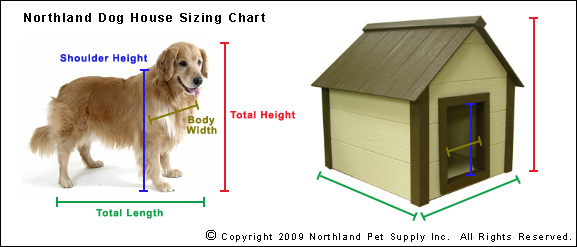When building a dog house, remember that it is not the be-all-end-allfor your pup. Having a shelter does not necessarily mean shade -- depending on the materials used, a dog can overheat even more quickly in a dog house than out in your yard. And no matter how nice the doghouse, it's not a suitable round-the-clock home for a pet.
Dog house kits start at around $100. When assembling one, you shouldn't need much beyond a hammer or screwdriver. Most kits include the floor, walls and roof, completely pre-drilled with instructions [source: Kit Guy]. It should also include the nails and other assorted hardware, though depending on the kit you may need to purchase insulation, paint, and a pad, pillow or mat for your dog to lie on.
When selecting a dog house, your biggest consideration -- even beyond the pros and cons of housing your pup in a barn versus a bungalow -- is the size. If you love a style for your German shepherd's house but can only find it in small and medium, look for a bigger model. Similar to a dog crate, your dog house should be large enough for your pet to get in fully, turn around, and lie down. By the same token, however, it shouldn't be too big. Pets aren't like people -- a Chihuahua won't appreciate all the space of an extra-large dog mansion. In that case, a small dog kit will do fine.
Custom Dog House
If you are looking for a unique dog house, you can always build one yourself from scratch. Of course, this type of building requires the most work -- you have to know carpentry in order to draw up plans, select all of the building materials, cut them to fit and then assemble the entire thing. It's the most work, but then you can be sure no one has a dog house quite like yours. You can also contract personal builders who will build a dog house to your specifications.
Most custom dog houses, however, actually work similarly to the dog kits discussed on the previous page. In general, you can select and slightly modify the design you like based on what the company has. You can then choose from different options to create a customized exterior [source: America's Pet Store]. Sometimes they can even match your own house. Custom houses such as these will usually come ready to assemble, with all of the cut materials and hardware provided. The higher-end custom dog houses can come already assembled, delivered to you via truck.
If you're starting from scratch or using a custom kit that allows you to choose your materials, you'll want to know exactly what works and what doesn't. "Lightweight" can sound good, but it might not be sturdy enough to hold up to your dog, especially if it is a chewer.
Choosing Dog House Materials
You can use just about any material to make a dog house, but some will work better depending on your climate and your dog's temperament. The most common materials for dog houses are either wood or plastic.
Wood is generally used the most, and you'll find most instructions use lumber in their examples. This is because wood is inexpensive and pretty easy to work with. Who hasn't made a simple wooden birdhouse or napkin holder? Wood is also easier to cut and can be used in the most climates. Cedar dog houses are best in areas that are wetter with high humidity [source: Wright].
Plastic can be a great alternative if you're looking for something lightweight and waterproof -- a huge advantage for an outside home. Plastic also cannot be destroyed by termites like wood can, but in both plastic and wood, select a sturdy material if your dog is a chewer.
Depending on where you live and what kind of materials you are using, you may also need to include insulation for your dog house. This is important not only in cold areas but also in hot ones -- insulation can keep your dogs from overheating. You can buy barriers and layers of insulation to use in the dog house or use pre-insulated panels [source: House of Hammocks].
How to Choose the Right Size of House for Your Dog

Important Dog House Tips
- Fill doghouses with hay or cedar chips in the winter so the dog will have a warm bed. (Cedar chips are preferable to hay because they are less likely to rot and don't contain mites.) If you use hay and it gets wet and soggy, spread it in the sun on a sunny day to dry it out.
- Doghouses should be large enough for the dog to stand up and turn around comfortably, but small enough to retain the dog's body heat.
- Wooden doghouses should be raised a few inches off of the ground to prevent rotting and keep out rain. Flat concrete blocks are an easy way to raise a doghouse.
- To protect the dog from winter cold, the door should be covered with a plastic flap. You can use a car mat, a piece of plastic carpet runner (you can buy this by the foot at home improvement stores), or even a piece of carpet.
- Dogs enjoy having towels and blankets to sleep on, just like we do. Remember to wash them every few weeks so they don't get stiff with dirt.
- A doghouse isn't the same thing as shade. The inside of a doghouse gets mighty hot in summer! Provide shade by planting trees or hanging a tarp the dog can get under. Be sure to provide plenty of water in summer, too, and a baby pool filled with water for cooling off.

Nice articles and your information valuable and good articles thank for the sharing information how to build dog shelters
ReplyDelete